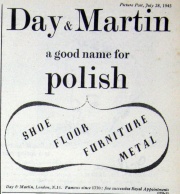Difference between revisions of "Day and Martin"
| Line 5: | Line 5: | ||
of 49 Borough Road, London, blacking manufacturer; later a supplier of polish. | of 49 Borough Road, London, blacking manufacturer; later a supplier of polish. | ||
[[Benjamin Martin (2)|Benjamin Martin]], a native of Doncaster, had worked as a hairdresser for Day's father in Covent Garden. | [[Benjamin Martin (2)|Benjamin Martin]], a native of Doncaster, had worked as a hairdresser for Day's father in Covent Garden. | ||
c.1800 Day and Martin started working together. Martin's brother-in-law, an innkeeper in Doncaster, had obtained a recipe for boot blacking*. | c.1800 [[Charles Day (1783-1836)|Charles Day]] and Martin started working together. Martin's brother-in-law, an innkeeper in Doncaster, had obtained a recipe for boot blacking*. | ||
1801 Charles Day commenced manufacture of blacking<ref>The Times, 11 July 1865</ref>. | 1801 Charles Day commenced manufacture of blacking<ref>The Times, 11 July 1865</ref>. | ||
Revision as of 08:26, 24 July 2020

of 49 Borough Road, London, blacking manufacturer; later a supplier of polish.
Benjamin Martin, a native of Doncaster, had worked as a hairdresser for Day's father in Covent Garden.
c.1800 Charles Day and Martin started working together. Martin's brother-in-law, an innkeeper in Doncaster, had obtained a recipe for boot blacking*.
1801 Charles Day commenced manufacture of blacking[1].
1801 Day and Martin formed a partnership as blacking manufacturers at 97 High Holborn. Day and Martin were among the pioneers of advertising.
1808 Day bought out Martin's interests and became sole proprietor.
1812 Premises at 97 High Holborn[2].
1816 The business was unsuccessful in a legal case brought against a counterfeiter of its products - Day and Martin were found to have no patent rights in their real japan blacking.
Perhaps c.1830 incorporated Jonathan Warren's blacking manufactory[3].
1836 Charles Day died on 26 October 1836, at 97 High Holborn, London. A court examination of his will went on until 1854; Charles Dickens made reference to such a case (believed to be this one) in the preface to Bleak House - Dickens had worked for Warrens, a rival of Day and Martin, in his younger days[4].
1890 The factory moved to Borough Road[5].
1896 Day and Martin became a limited company
1899 The company was registered on 9 February, as Day and Martin (1899) (the name being subsequently changed as above), to take over the business of blacking manufacturers of Day and Martin. [6]
1907 Range of more than 80 products[7].
1919 Acceptance of offer from Hargreaves Brothers and Co which would result in an exchange of shares[8].
1920 Was an associated company of Hargreaves Brothers and Co of Gipsyville, Hull, who had a substantial shareholding in the company[9].
1922 Reckitt and Sons acquired Hargreaves Brothers and Co.
1923 The directors decided to sell the business by auction
1923 The business was sold to Carr and Son of Southgate[10], an equally famous firm that had been established in 1837[11].
1923 A new firm, Carr and Day and Martin Ltd, was registered [12].
1925 Day and Martin was voluntarily wound up; there was cash in the bank and the nameplate, assets, etc. had been sold[13].
1945 Advert as supplier of polishes - see inset
By 1950, Carr and Day and Martin had re-designed the packaging of their entire product range.
1976 Carr and Day and Martin Ltd was acquired by Nolton Estate[14]
Up to the 1990’s, the Carr and Day and Martin equestrian product range consisted mainly of leather care products including saddle soap, polish and oil. Further horse care products were then launched.
- Another source [15] says that around 1770, a Mr Martin, surgeon-barber of Doncaster, obtained the recipe for blacking from a soldier. He sent his son to his cousin/ the son's uncle, F. Day, perfumer and hairdresser of Covent Garden, with the recipe. The two cousins (which?) made up the recipe and offered it for sale. By 1804 the partnership of Day and Martin was still operating from Covent Garden (advert in the Morning Herald).
See Also
Sources of Information
- ↑ The Times, 11 July 1865
- ↑ The Times, 23 April 1907
- ↑ The Times, 23 April 1907
- ↑ The Times, 20 March 1926
- ↑ The Times, 23 April 1907
- ↑ The Stock Exchange Year Book 1908
- ↑ The Times, 23 April 1907
- ↑ The Times, 17 April 1919
- ↑ The Times, 5 July 1920
- ↑ The Times, 26 April 1923
- ↑ Carr and Day and Martin website [1]
- ↑ The Times, 14 August 1923
- ↑ The Times 12 August 1925
- ↑ The Times 27 January 1976
- ↑ Advert for Day and Martin in The Times, Tuesday, Apr 23, 1907
- Biography of Charles Day, by T. A. B. Corley, ODNB [2]




